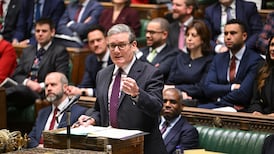The effective sacking of Sue Gray as his chief-of-staff brings more negative publicity for Keir Starmer but is being viewed in Westminster as necessary to fix a mistake he made on day one as Britain’s prime minister: allowing two competing power bases to take root in his Downing Street operation.
In his decision to cull one power base – Gray, the former civil servant whose job was to help Labour navigate Whitehall – and cementing the status of the other – Irishman Morgan McSweeney, Starmer’s political guru and new chief-of-staff – the prime minister has picked a side in their row.
McSweeney, the son of a Macroom, Co Cork, accountant, is now arguably the most powerful person in British politics after the prime minister. Not even Rachel Reeves, the UK’s chancellor, or Angela Rayner, the deputy prime minister, would be seen as having more influence on the man who leads Britain.
That there was a serious rivalry between Gray and McSweeney was known in Westminster long before July’s election. She was the subject of scores of vituperative briefings from people close to McSweeney, and there was a sense that Labour’s top team were at each other’s throats all through the spring. Hostilities were only temporarily set aside when the election was called.
READ MORE

They had both played a role in getting the prime minister to where he is today.
The Corkman was the political brain behind Starmer’s precipitous rise to the top of the Labour Party, and then to Downing Street. When Starmer almost quit after losing the Hartlepool byelection in 2021, it was McSweeney who dragged him back to his feet and helped him rebuild Labour.
But as it became clear following the debacle of Liz Truss’s tenure in Downing Street that Labour was firmly on course to return to power, Starmer turned to Gray, the daughter of Irish immigrants who was one of the top civil servants in Whitehall, to help him prepare for Downing Street.
McSweeney had helped Starmer plot his course to political power but Gray was going to help him wield it once he got there. That was meant to be their demarcation: Gray was supposed to “do” government while McSweeney did politics. But they wrestled for influence with the prime minister.
In the white heat of scrutiny that comes with his hot seat Starmer has found that doing government and doing politics are indivisible tasks. He had to make a choice, and he picked McSweeney.
By all accounts Gray fought hard last week to keep her place at the heart of government. But in the end the decision on her exit, portrayed publicly as a resignation, was in reality made for her by the prime minister. She is now being tipped as a contender for a seat in the House of Lords.
There was some sympathy for Gray on Monday among some in Labour’s ranks, who felt she had taken too much of the blame for the party’s bad start in government, which has included distractions such as stories about ministerial freebies. Others, however, said that if she was the one who was meant to help Labour come up with a plan for government, where was it?
Labour’s communications machine had misfired all over the place in recent weeks. Gray was meant to be in charge of the so-called “grid” of planned announcements that help the government navigate Westminster’s news cycles. There was little evidence that she was on top of that task.
Starmer has also shaken up his Downing Street team on the rungs below McSweeney. Former lobby journalist James Lyons has joined as head of strategic communications, with responsibility for managing the media grid. His first job will be to tame the sense of communications chaos that has gripped Starmer’s first few months on the job.
- Listen to our Inside Politics Podcast for the latest analysis and chat
- Sign up for push alerts and have the best news, analysis and comment delivered directly to your phone
- Find The Irish Times on WhatsApp and stay up to date















